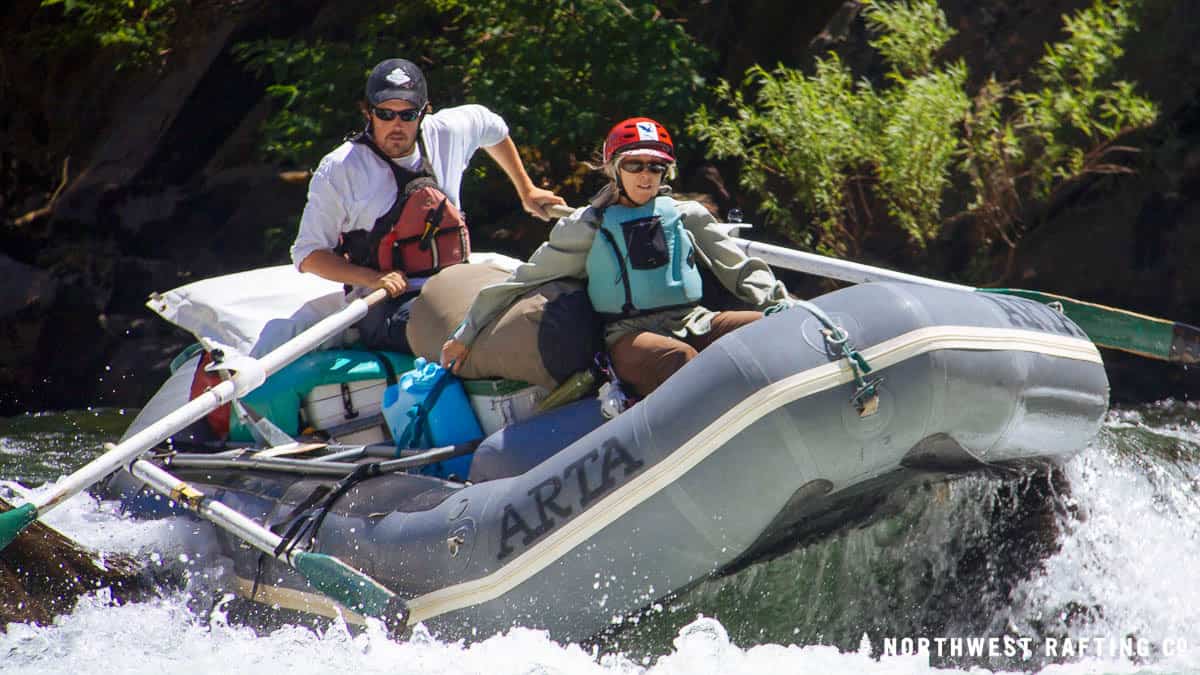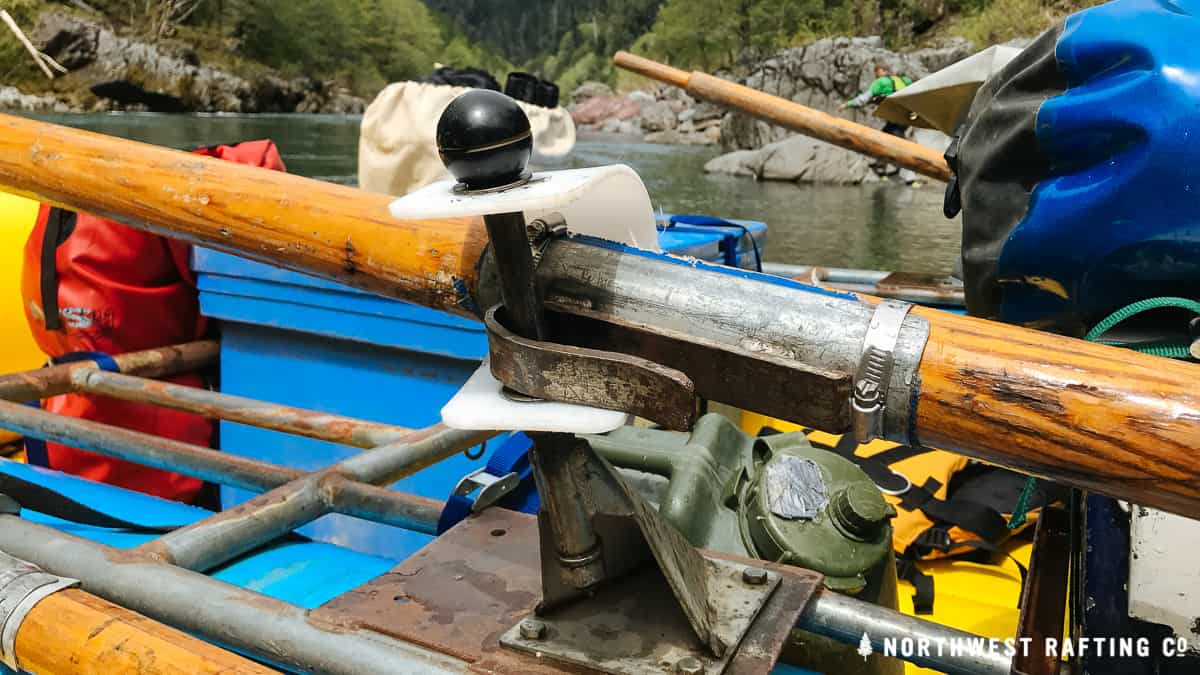Deciding between the two most common oar retention systems, oar locks and pins and clips, is a common debate among boaters. It’s much like the “ale vs lager” debate for beer drinkers. Some people only drink one type of beer, say derogatory things about the alternative and couldn’t fathom switching sides; enlightened people realize that there are times and places for both.
Most rowers feel strongly about one method of attaching their oars to their frames, but have little or no experience with the alternative methods. I learned to row with pins and clips, but have used oar locks extensively as well. I can say with certainty, that there are advantages to both.

First, let’s start with some history. Oar locks are an ancient technology that go way back to before whitewater rafting became a sport. The first oar locks were made of wooden Vs that a wooden oar rested on. Pins and clips were designed specifically for whitewater rafts in the 70s and consist of a vertical pin attached to the boat and a clip attached to the oar. Second, let’s delve into some vocabulary:
Shipping Oars: To the boys at Sawyer, this means putting them in a box and giving them to the UPS guy. To the rest of us it means moving the handles backwards and the blades forward so that the oars tuck up against the raft.

Feathering: Adjusting the angle of the oar with oar locks. This gives you a better feel for the water as you row.
Yard: To pull really hard on one or both oars, almost blindly, often in desperation, often necessarily. From the sailing term “yard” for a horizontal spar that supports a main sail (and bears a lot of weight and stress).
Oar Locks
Oar locks are preferred by many because they allow the rower to adjust the angle of the blade in the water. You can also cut the wind when the oar is out of the water, which makes for a slightly more efficient stroke.
When your oars catch funny currents underwater, oar locks allow you to twist the oar, thereby reducing the chance the oar is unwillingly pulled from your hand. They also allow for a sculling stroke, skimming the blade over the surface of turbulent water and adjusting the angle to vary resistance.

Another advantage of oar locks is that you can move the oar in and out laterally so you can row while standing. This allows you to change the balance point, which reduces the weight of the oar beyond the locks. Another nice thing is that you can pull the oars in to get through narrow spots, however, you still need to ship the oars when immediately next to a rock (or other obstacle).
The downside of oar locks is that you must control the angle of your blade. In chaotic whitewater you don’t always have the time to adjust the angle and the time delay can make a difference in challenging whitewater. Since you control the angle of the oar, you may not be pulling with full strength. Some people mitigate this disadvantage by using an oval grip or other method to ensure their grip of the oars is at the correct angle to allow for maximum force of the blade.

Another problem with locked oars is that when the oar hits a rock, it can fully pop out of the oar lock and will take some time to get back in the lock and be ready to row. Of course with pins and clips, the oar can break when this happens.
“One advantage of oar locks is the simplicity of the design. Less parts and mechanical components means less equipment malfunction and repair. In terms of elegance of design, Steve Jobs would definitely have mandated the oar lock.” – Hata Hill, legendary guide
Oar Lock Recommendations: For rivers with lots of flat water and/or heavy winds. Better for finesse boaters.
Pins and Clips

The biggest advantage of pins and clips is that your oar will maintain its position and blade angle. This is great for more challenging whitewater and big, violent whitewater where you are likely to be thrown around the boat. Knowing that the oar will be in place when you drop it in the water allows for a quicker oar stroke and allows you to quickly “yard” on the oar with full strength.

Another advantage in more difficult whitewater is that an oar pinned in place can be used as a stabilization tool for the rower as they punch through huge waves or over big drops. Pins and clips allow the rower to hold on to his/her oars at all times. Oars with pins and clips are also more likely to be useable after a reflip.

Pins and clips are also considered safer for oar assisted paddle boats since the oar is still held in place after it pops out. Even when the pin is out of the clip, it still can be used since it is held by the white plastic retainer. An oar can be put back in place with one hand instead of the two hands it takes to replace an oar when using oar locks. This reduces the opportunity for an oar to be wildly flying around in a rapid and hit somebody.

One of the downsides of pins and clips is that when going past rocks you’re forced to either ship the oars or throw them forward; you can’t pull the oars into the boats like you can with oar locks. Also, since the oars are more rigidly attached, you are more likely to break oars using pins and clips, and those breaks tend to be more violent.
Pins and clips can also take quite a bit of tinkering to get them just right. You need a nut driver to adjust the hose clamps in order to adjust the position and angle of the oars. If the hose clamps aren’t tight, then they can slip mid rapid and you’ll have a hard time adjusting them back quickly.

Another disadvantage is that you can’t feather the oars, so you have less finesse. If your oar catches strong underwater currents, it could be ripped from your hand or it could pull your arm out of your socket if you’re gripping it tightly.
“No argument that oar-locks win the aesthetics, simplicity and finesse contests; but when it comes to the right-here, right-now, this stroke has to be perfect and powerful and productive (and I might need a little more help staying in the raft) contest; I think pins and clips win. If rowing is an art-form, chisel with locks; if rowing is a job, blast with clips. I admire Steve Jobs but I wouldn’t have hired him to move a piano.” – Mikey Bigwater, legendary ARTA guide
Pins and Clips Recommendations: Huge water and Class V when oar power and attachment is key. Better for power boaters.
Oar Rights
Some people think that oar rights are the best of both worlds. These are plastic spacers that hold an oar’s angle in the oar lock. You get the predictability of pins and clips with the simplicity of the oar locks. You can also pull the oars in to avoid obstacles.

Some people think they’re the worst of both worlds because you lose the ability to feather the oars and the stability of the oar along its length, which can help keep you in the boat.
Conclusion
The key to choosing the right oar retention system is to decide which things are important to you on the river and to try both out. We can talk about this more over a beer. I’ll have a lager, not one of those pissy ales, thank you!
Thank you to Steve Welch and Hata Hill for their thoughts on this debate.
This is a lively topic and we’d love to hear what you think in the comments below!

